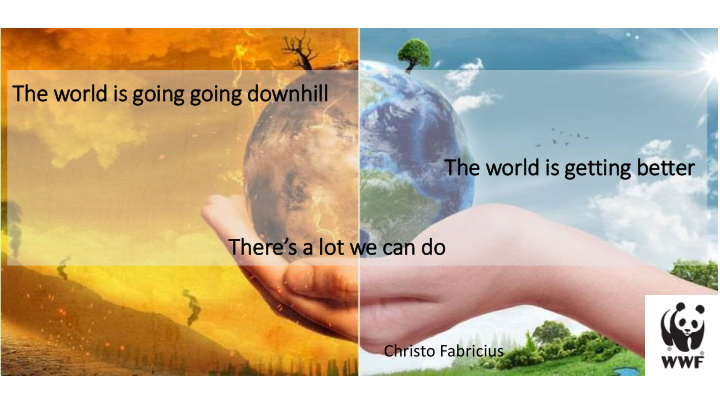



The world ld is is going going downhill ll The world ld is is getting better There’s a lot we can do Christo Fabricius
The world is going downhill
There’s just too many of us..
The Great Acceleration: Socio-economic trends
The planet is FULL now
And we consume too much
The Global Living Planet Index 1970 to 2014
We are putting ourselves at risk
and people aren’t getting happier..
The world is getting better…
A rising Human Development Index
There are fewer people without education
Rate of population growth could slow down
Many diseases are under control
Healthy people on an unhealthy planet?
There’s a lot we can do
Every 0.5 degrees matters • A a 1.5°C threshold • Can avoid millions of premature deaths from heat stress, malnutrition and air pollution • 10 million fewer people exposed to sea-level rise • 1.5 million additional tonnes of fish stocks • 50% fewer people living with water scarcity • At 2°C vs. 1.5 • Double the duration of heatwaves to 40 days • Warm extremes increase 600% • Number of dry days & rainfall extremes increase • Average drought length last six months longer • 5-million more people living with water scarcity at 2°C compared with 1.5°C
Transforming food systems
Renewable Energy • Renewable energy sources in South Africa cost nearly half the price of electricity generated from coal mines • We could save R86 million a year by 2050 if we use renewables
What progressive companies can do 1. Support decarbonization of the energy sector. Invest in renewable energy 2. Get ahead of the curve: set a science-based emission reduction target for your business 3. Make sure your voice is heard
Invest in Nature Potential for cost-effective reduction and absorption of CO2 • Burning & clearing of tropical forests: Wetlands 14% 16 percent of global carbon dioxide Agriculture: 21% (CO2 ) emissions Grasslands; 0,0; 0% • more than all the world’s cars, trucks, airplanes and ships combined Agriculture Forests Grasslands • Unsustainable agriculture: 14% of CO2 Wetlands emissions. Forests; 65% • Halting emissions from forests and sustainable agriculture, conserving natural ecosystems, is essential to resolve the climate challenge.
Investing a nature: a business opportunity? • Save on disaster management costs • Create jobs • Leverage funds from corporations setting science-based targets • Water security • Energy saving • Food security • Innovation GET AHEAD OF THE CURVE TO BEND THE CURVE
Recommend
More recommend